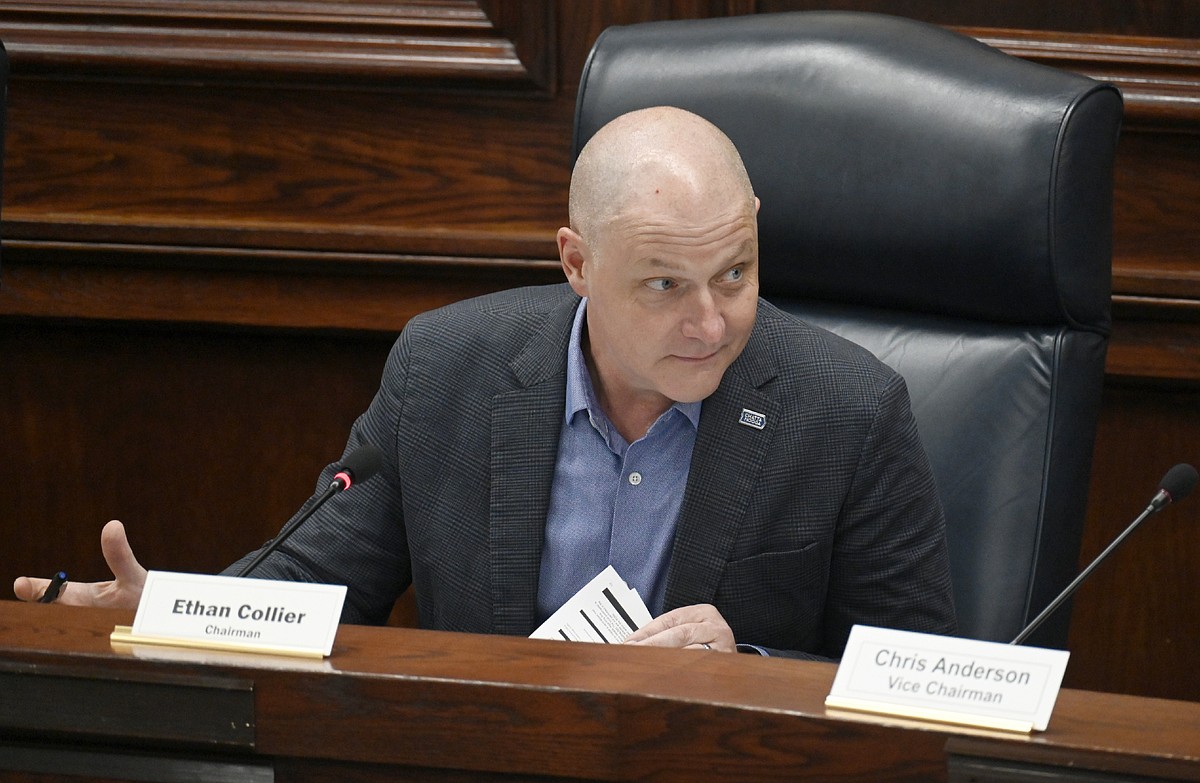New Jersey DEP wants city to commit to Trenton Water Works regionalization [UPDATED] – Trentonian
![New Jersey DEP wants city to commit to Trenton Water Works regionalization [UPDATED] – Trentonian](https://www.trentonian.com/wp-content/uploads/2025/08/tww-photo-collage.jpg?fit=620,9999px&ssl=1#)
Report on the Trenton Water Works Infrastructure and Governance Crisis
Executive Summary
A report from the New Jersey Department of Environmental Protection (NJDEP) has escalated pressure on the City of Trenton to restructure the Trenton Water Works (TWW) utility. The directive highlights severe operational deficiencies that pose a direct threat to public health and safety, fundamentally challenging the region’s ability to meet Sustainable Development Goal 6 (SDG 6): Clean Water and Sanitation. The state’s push for a regional governance model has been met with resistance from Trenton officials, who cite concerns over local autonomy and equitable governance, invoking principles central to SDG 11 (Sustainable Cities and Communities) and SDG 16 (Peace, Justice and Strong Institutions). The situation underscores a critical conflict between the urgent need for safe water infrastructure and the complexities of establishing effective, multi-stakeholder partnerships as envisioned in SDG 17 (Partnerships for the Goals).
NJDEP Assessment: A Failure to Meet SDG 6
Critical Deficiencies in Water Infrastructure
An NJDEP investigation, including a surprise visit to the TWW filtration plant, revealed conditions that compromise the utility’s ability to provide safe and reliable drinking water. The findings represent a significant failure to uphold the core tenets of SDG 6, which mandates access to safely managed drinking water for all.
- NJDEP Commissioner Shawn LaTourette described the facility’s condition as “extremely poor.”
- The assessment identified a “high risk of systemic failure” that is both “obvious” and “alarming.”
- Persistent “serious safety and health concerns” were documented, indicating a direct risk to the 200,000 residents served by the utility.
- The NJDEP noted that despite some progress under state oversight, TWW has experienced “backsliding on issues critical to the maintenance of adequate water supply and the protection of public health.”
State Mandate for Restructuring
In response to these findings, the NJDEP has formally requested that the Trenton City Council commit to exploring a restructuring of TWW. This action is framed as a necessary intervention to ensure the long-term viability of the water system, a key component of resilient urban infrastructure under SDG 11.
- The NJDEP has requested that TWW restructuring be placed on the City Council’s August 5 agenda.
- A formal commitment from the City on its intent to explore restructuring was requested by August 8.
- The state intends to shift its role from daily operational support to increased “compliance, enforcement, and capital planning support,” placing the onus of sustainable management back on the utility’s governing body.
Governance and Institutional Challenges (SDG 16 & SDG 11)
Trenton’s Stance on Local Autonomy and Asset Control
Trenton’s elected officials have responded with strong opposition to what they perceive as state coercion, arguing that any restructuring must respect the city’s authority and its role as steward of a valuable public asset. This position highlights the importance of SDG 16, which advocates for effective, accountable, and inclusive institutions at all levels, and SDG 11, which supports local government control over municipal planning and management.
- Mayor W. Reed Gusciora stated the city would not be “strong-armed into a predetermined outcome—namely, regionalization—without proper due diligence, public engagement, and accountability.”
- The Mayor emphasized that TWW is one of the city’s “most valuable assets” and that the City Council is the sole entity empowered to authorize restructuring.
- Council President Yazminelly Gonzalez and Councilwoman Crystal Feliciano echoed these sentiments, stating they will not support initiatives that remove “Trenton’s seat at the table.”
Calls for Transparency, Accountability, and Institutional Reform
City leaders and council members have called for greater transparency and direct engagement from the NJDEP. Concurrently, internal governance failures at TWW have been acknowledged, pointing to a need for institutional reform to achieve the targets of SDG 16.
- Council President Gonzalez invited NJDEP officials to a public City Council meeting to ensure “transparency and public engagement.”
- Councilwoman Jasi Edwards cited a lack of direct communication and highlighted persistent internal issues, including:
- No formal internal structure or staff evaluations.
- Limited oversight and inconsistent training.
- Low morale and minimal collaboration between TWW and DEP.
- No clear strategy for long-term infrastructure or climate resilience, a key target of SDG 11.
Multi-Stakeholder Engagement and Regionalization (SDG 17)
Proposed Restructuring Models
A study released in January outlined several governance options for TWW. The recommended model promotes a regional partnership, aligning with the principles of SDG 17, which encourages multi-stakeholder collaborations to achieve sustainable development.
- Options ranged from maintaining the status quo to complete privatization.
- A regional oversight board, giving all service-area municipalities direct oversight while allowing Trenton to maintain partial control, was identified as the option offering the best value and lowest overall rate increases.
Perspectives from Suburban Municipalities
Leaders from surrounding municipalities served by TWW have voiced strong support for a regional solution, emphasizing the urgency of addressing public health risks and the need for a collaborative governance structure, reinforcing the call for a partnership under SDG 17.
- Hamilton Mayor Jeff Martin stated, “The status quo is unsustainable,” and expressed hope that leadership will prioritize the public health of all residents.
- Hopewell Township Mayor Courtney Peters-Manning asserted that the crisis requires a regional solution, stating, “the suburban towns deserve a seat at the table.”
Analysis of Sustainable Development Goals in the Article
1. Which SDGs are addressed or connected to the issues highlighted in the article?
The article on the Trenton Water Works (TWW) crisis touches upon several interconnected Sustainable Development Goals. The primary issues of ensuring safe drinking water, managing urban infrastructure, protecting public health, and resolving governance conflicts directly relate to the following SDGs:
- SDG 6: Clean Water and Sanitation: This is the most central SDG, as the entire article revolves around the “extremely poor conditions” of a water utility, the safety of the drinking water it provides, and the management of water infrastructure.
- SDG 3: Good Health and Well-being: The article repeatedly emphasizes the “serious safety and health concerns” and the potential risks to “public health.” The primary motivation for the state’s intervention is to prevent health crises resulting from contaminated water.
- SDG 11: Sustainable Cities and Communities: The TWW is a critical piece of urban infrastructure. The debate over its management, funding (“decades of underinvestment”), and resilience (“no clear strategy for addressing… climate resilience”) falls under the goal of making cities and human settlements inclusive, safe, resilient, and sustainable.
- SDG 16: Peace, Justice and Strong Institutions: The conflict between the New Jersey Department of Environmental Protection (NJDEP) and Trenton city officials highlights a crisis in governance. Issues of transparency, accountability, institutional capacity (“no formal internal structure,” “not enough qualified staff”), and public participation (“meaningful local input”) are at the forefront of the debate, directly linking to the goal of building effective and accountable institutions.
2. What specific targets under those SDGs can be identified based on the article’s content?
Based on the specific problems and proposed solutions discussed in the article, the following SDG targets are identifiable:
- Under SDG 6 (Clean Water and Sanitation):
- Target 6.1: “By 2030, achieve universal and equitable access to safe and affordable drinking water for all.” The article’s focus on ensuring “reliably clean and safe drinking water” for 200,000 residents directly addresses this target. The “high risk of systemic failure” described by the NJDEP is a direct threat to achieving this goal.
- Target 6.b: “Support and strengthen the participation of local communities in improving water and sanitation management.” The calls from city officials for “public engagement,” “meaningful local input,” and ensuring Trenton has a “seat at the table” reflect the importance of this target in the restructuring process.
- Under SDG 3 (Good Health and Well-being):
- Target 3.9: “By 2030, substantially reduce the number of deaths and illnesses from hazardous chemicals and air, water and soil pollution and contamination.” The NJDEP’s intervention is driven by “serious safety and health concerns” and the need to protect the public from potential water contamination, which aligns with this target.
- Under SDG 11 (Sustainable Cities and Communities):
- Target 11.1: “By 2030, ensure access for all to adequate, safe and affordable housing and basic services…” Safe drinking water is a fundamental basic service. The article highlights the struggle to maintain this service due to an “aging facility” and “decades of underinvestment.”
- Target 11.b: “By 2030, substantially increase the number of cities and human settlements adopting and implementing integrated policies and plans towards… resilience…” A councilwoman’s statement points to a failure in this area, noting there is “no clear strategy for addressing long-term infrastructure needs or climate resilience.”
- Under SDG 16 (Peace, Justice and Strong Institutions):
- Target 16.6: “Develop effective, accountable and transparent institutions at all levels.” The article details the institutional failings of TWW, including “no formal internal structure, no staff evaluations, limited oversight of leadership and staff, not enough qualified staff, and no real succession planning.” The entire conflict underscores a need for more accountable and transparent governance.
- Target 16.7: “Ensure responsive, inclusive, participatory and representative decision-making at all levels.” The mayor’s refusal to be “strong-armed into a predetermined outcome—namely, regionalization—without proper due diligence, public engagement, and accountability” is a direct call for a more inclusive and participatory decision-making process.
3. Are there any indicators mentioned or implied in the article that can be used to measure progress towards the identified targets?
The article provides several qualitative and quantitative indicators that can be used to measure progress:
- Physical Condition of Infrastructure: The “extremely poor conditions” of the TWW filtration plant, documented by NJDEP photos, serve as a baseline indicator. Improvements to the facility would be a measure of progress.
- Water Safety Declarations: The statement that the “DEP has never declared Trenton’s water unsafe” is a key indicator of public health protection. Any future advisories or declarations would indicate a decline in safety.
- Governance and Management Structure: The current “status quo” is one indicator. The adoption of a new structure, such as the proposed “regional oversight board,” would be a measurable outcome. The existence of a “formal internal structure” and “succession planning,” currently absent, would be another key performance indicator for institutional strength (Target 16.6).
- Public and Stakeholder Engagement: The number of public meetings held where officials and the public can engage is a direct indicator of participation (Target 16.7). The article mentions a specific invitation for the DEP to attend the “Aug. 7 City Council meeting.”
- Customer Satisfaction: The mention that “customer billing is a constant complaint” serves as an informal indicator of public service dissatisfaction (related to Indicator 16.6.2). A reduction in such complaints would signify improvement.
- Compliance and Enforcement Actions: The NJDEP’s plan to “increase compliance, enforcement, and capital planning support” implies that the number and severity of enforcement actions are being used as an indicator of the utility’s performance.
4. Summary Table of SDGs, Targets, and Indicators
| SDGs | Targets | Indicators Identified in the Article |
|---|---|---|
| SDG 6: Clean Water and Sanitation | 6.1: Achieve universal and equitable access to safe and affordable drinking water for all. | – Provision of “clean and safe drinking water” to 200,000 residents. – Physical condition of the TWW filtration plant (“aging facility,” “extremely poor conditions”). |
| 6.b: Support and strengthen the participation of local communities in improving water and sanitation management. | – Level of “public engagement” and “meaningful local input” in the restructuring process. – Trenton’s “seat at the table” in decision-making. |
|
| SDG 3: Good Health and Well-being | 3.9: Substantially reduce illnesses from water pollution and contamination. | – Absence or presence of official declarations that the water is “unsafe.” – Level of “serious safety and health concerns” identified by the NJDEP. |
| SDG 11: Sustainable Cities and Communities | 11.1: Ensure access for all to adequate, safe and affordable basic services. | – Reliability of the water utility, which is at “high risk of systemic failure.” – Level of investment to counter “decades of underinvestment.” |
| 11.b: Implement integrated policies and plans towards resilience. | – Existence of a “clear strategy for addressing long-term infrastructure needs or climate resilience” (currently noted as absent). | |
| SDG 16: Peace, Justice and Strong Institutions | 16.6: Develop effective, accountable and transparent institutions. | – Existence of a “formal internal structure,” “staff evaluations,” and “succession planning” (currently lacking). – Frequency of “customer billing” complaints. |
| 16.7: Ensure responsive, inclusive, and participatory decision-making. | – Number of public council meetings held for discussion. – Level of agreement on a governance model (e.g., regionalization) that includes “proper due diligence” and local input. |
Source: trentonian.com
What is Your Reaction?
 Like
0
Like
0
 Dislike
0
Dislike
0
 Love
0
Love
0
 Funny
0
Funny
0
 Angry
0
Angry
0
 Sad
0
Sad
0
 Wow
0
Wow
0



























;Resize=805#)



















































